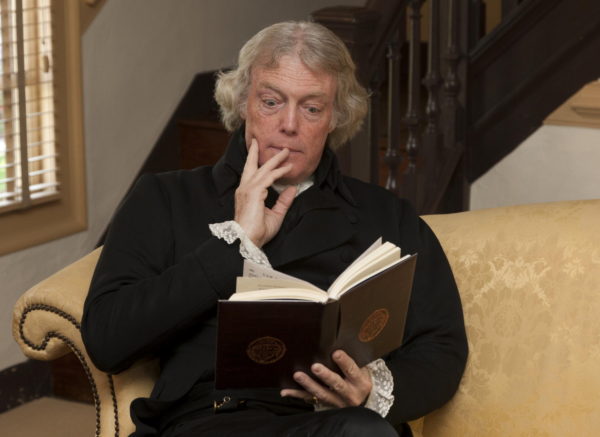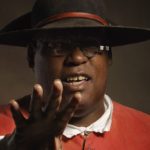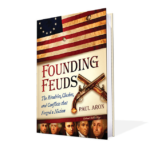
It’s National Book Lovers Day, which means it’s time again to see what my colleagues are recommending. You remember books-those paper objects that people carried around before “reading devices.” Ignoring the darkening skies, I head down Duke of Gloucester Street with notebook in hand, ready to add to my reading list.
The Tailors (in their new digs!) and the Joiners are stacked deep with guests, so I decide to catch them on the way back to the office. In the field next to the Courthouse I stop to watch some of our interpreters teaching kids how to play Trap Ball. I’m jealous—I want to take a swat at the leather ball, too.
But I content myself to sidle up to a couple of my costumed colleagues, Brenda and Valerie, and ask them what they recommend for our guests. They’re both partial to Williamsburg Before and After.
“A lot of our guests are really interested in the reconstruction, and what happened to the town in between the 18th century and what you see now,” says Brenda. It’s got stories and some great photographs of families that lived here, like the Jones family at the Secretary’s Office. My favorite one shows the John Crump House, with the whole building leaning over.”
Valerie adds that the Official Guide to Colonial Williamsburg is also really useful for learning the history of the Revolution in Williamsburg and the reconstruction, and figuring out which buildings are original.
At the Capitol I approach a couple of our sites interpreters, who are getting ready to lead a tour that will tell the story of women and the law in 18th-century Virginia. Whitney is a fan of A Perfect Union: Dolley Madison and the Creation of the American Nation by Catherine Allgor. “It shows how James and Dolley were America’s first real power couple. The War of 1812 wouldn’t have been nearly so successful if people didn’t care about the White House burning, and they wouldn’t have cared about the White House burning if Dolley hadn’t used ‘petticoat politics’ to actually make it something that people cared about. I might sound a little biased, but really I wasn’t until I read this book.”
Lisa, Whitney’s colleague at the Capitol, has been mulling over what to recommend. She really likes how David McCullough’s biography of John Adams illuminates Revolutionary politics of the Continental Congress and Adams’ perspective on Virginia. But she settles on Independence: The Struggle to Set America Free by John Ferling. “It’s great because it goes to the actors on both sides of the ocean, including Parliament and the British ministers. It’s really well-researched and enjoyable.”
As I leave the Capitol I see a familiar friendly face over at the Gunsmith. It’s Eric, an Apprentice Gunsmith, who’s taking lunch on the bench in front of the shop. So what’ll it be, Eric? A military history? A swashbuckling historical fiction? Nope. He’s staying close to his craft, recommending The Gunsmith in Colonial Virginia by Harold B. Gill, Jr.
“If you’re wanting to learn about our world, gunsmithing in 18th-century Tidewater and Williamsburg, this is the gold standard. It’s short and concise, and it’s drawn almost entirely from direct, firsthand sources. It’s pretty remarkable. There are other books that cover the broader story of colonial gunsmithing, but this one will tell you exactly what gunsmiths here were producing, how much things cost, which puts it into perspective.”
I thank Eric and take my leave, head west back down DoG Street, just as it starts to sprinkle.
Regina welcomes me immediately when I duck into the Wigmaker Shop. So what do you pick up if you want to rock a period hairpiece in the ‘burg? Regina likes to recommend The Wigmaker in Eighteenth-Century Williamsburg (subtitle: An Account of His Barbering, Hair-Dressing, & Peruke-making Services, & Some Remarks on Wigs of Various Styles.) It’s an entry in the Williamsburg Craft Series that offers brief overviews of various trades.
“It talks about the wigmakers here—who wore them, their occupations, the whole who-what-where-when-why of wigmaking in Williamsburg. It shows you how wigs were made, all the various styles, what classes of society were wearing them, and what wigmakers were represented in Williamsburg.”
Down the road a piece, I step into Anderson House, a building with offices where I can usually count on finding several interpreters on break or between scenes they are acting in. It seems unusually quiet, but I do find Felicity, who portrays Native American women. She’s reading intently in a chair near a front window.
Her pick? “A lot of our research is dissertations or original journals, but I like The Bringing of Wonder by Michael Morris. It’s about the Cherokee trade in North Carolina in the 1700s. There’s actually three sections about women, and it’s pretty unbiased. The guy actually even challenges some common biases by talking about the sexual freedom of the women. The last few chapters tell how they start to regulate the trade, and why.”
I’m thinking of the stops I still have to make when the heavens open and I’m not especially near any shelter. Whoops. Already soaked through, I finally find a small porch, where I consider my options. The rain isn’t letting up.
Finally, realizing I’ve been carrying a couple of books around as props, I sit down on the doorstep, open up, and start to read. Inventing George Washington, by Edward Lengel. It’s an insightful look into the evolution of Washington as a mythic figure, from Parson Weems to the way the father of our country is interpreted at historic sites today.
So… what do you recommend?


Jane Bell says
“Martha Jefferson Randolph: Daughter of Monticello “. Martha Jefferson Randolph was an amazing woman.
Another great Noel-Hume book….Martin’s Hundred…excellent account of the digging at Carter’s Grove….
“The Crisis of the Revolution” by William Abbatt. Originally published in the, reprinted in 1976…
For anyone wanting to read anything on John Andre and how the West Point plot unravelled 🙂
Janice Mae McDowell says
Well said. I enjoyed that book as well. Mrs. Washington was a grand lady, a good wife dedicated to her husband’s well being. She added a great deal to the positive experiences of the leaders and soldiers during the winter encampments. She was a source of comfortable to her family.
I have not read too many books that puts flesh on the bones of our early American patriots like David Hackett Fischer’s “Paul Revere’s Ride.”
In this book, Fischer brings the times of Boston’s colonial past vividly to life and I feel readers who tend to see the past as more than just words in a book, will enjoy this immensely, for through his writing style, history does come alive..
And Fischer busts some myths along the way!
Yup - this one’s my recommendation!
Austin Tullier says
I strongly recommend to anyone interested in a less talked about Founding Father, The Life and Speeches of John Hancock by Brandes, and Lorenzo Sears’ The Picturesque Patriot, which is on Google Books for free!! They’re both very good and written straightforwardly without trying to mold Hancock to their own view of him like Unger did in that biography that was too atrocious to finish!
Well, commenters to this article, you have caused me to acquire three titles so far, not that I can blame anyone for my book acquisitions disease! I require no provocation beyond knowing that they exist, much to my wife’s sorrow, but I do read them all.
Perhaps a gardener at the Colonial Garden would suggest a favorite book of mine - Founding Gardeners by Andrea Wulf.
It weaves together Washington, Adams, Jefferson and Madison and their mutual interest in gardening during the early years of the Republic’s history.
Fascinating!
Washington’s Grand Idea - a fascinating tale about what GW did after the Revolution but before the Constitution: https://www.amazon.com/Grand-Idea-George-Washingtons-Potomac/dp/0743263006
Juleigh says
I like Ivor Noel-Hume’s “1775: Another Part of the Field” (NY: Knopf, 1966). It’s arranged chronologically and takes the events reported in the Virginia Gazette as the base point.. Then Noel-Hume fleshes out the newspaper accounts and gives the reader a wider understanding of the period.
For a different viewpoint, I suggest “Tories: Fighting for the King in America’s First Civil War” by Thomas B Allen. Only a minority of colonials opposed the King and fought against him. A sizeable portion took no sides. Approximately a third remained loyal to George III and lost their positions, their property, and sometimes their lives as a result. I recommend that Americans read this, and then ask themselves, “Which side would I really have supported?”
I read American history from pre-Jamestowne to mid-20th century. Ours is a remarkable saga of evolution and change as a people. I recommend A Magnificent Catastrophe: The Tumultuous Election of 1800, America’s First Presidential Campaign by Edward J. Larson. It puts paid to any illusions that ours was in any way a smooth path to Republic and democracy after independence. Adams, Jefferson and Hamilton violently disagreed about what a nation of free people meant or how they should govern themselves. We have been disagreeing and evolving to this day!
Cindy Martin says
Fighting Over The Founders by Andrew M. Schocket
I just finished Martha Washington: An American Life by Patricia Brady (on the recommendation of Katherine Pittman, who portrays the young Martha). Ms. Brady’s style is very readable and she offers a different perspective on Martha than the dowdy national grandmother that the portraits of her in later life show: that of a woman whose charm and warmth were unshakable even in very difficult circumstances.
Lois Ann Mitchell says
I love this guy!! All books named are amazing!!
Daniel Keller says
John Adams by David McCollough
Janice Mae McDowell says
Enjoyed your essay! I love the Before and After Reconstruction of Williamsburg! I hope to read the book about the murder of George Wythe. I am Murdered.
I’ve read this and great read.